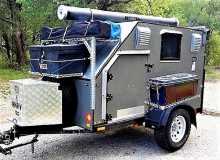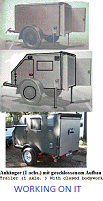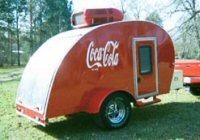active bumpstop used as a shock absorber substitute
16 posts
• Page 1 of 2 • 1, 2
active bumpstop used as a shock absorber substitute
Since I just completed the frame repair and axle/spring upgrade on my trailer,http://www.tnttt.com/viewtopic.php?f=21&t=58985 I was seeking a way to prevent a recurrence of breakage and also a way to absorb/spread the impact of large shocks to the suspension components. After much research and measurements as to which way to mount a set (requiring modifying the tie-plates for the lower mounts, and drilling more holes in the frame for the upper mounts), I wondered if all the added hardware would accomplish that task any better than a method I had used before. It seems to me that the shock and resulting jounce could be ameliorated to a satisfactory degree by inserting a progressive-rate EVS foam bump stop in between the frame and axle. Pretty much the same as Timbren uses hollow rubber "springs" in their axle-less systems, and in their Aeon line of suspension aids. I had used a similar bump stop, also mounted to be in close contact with the frame (except it was a solid polyurethane block- and was much stiffer than the EVS foam) in the rear suspension of my '86 S10 (modified for flat cornering and excessive weight loads). At first, it was very stiff and unforgiving over all surfaces, but I drilled varying sizes of holes in the poly, to create progressive stiffening, and it served me well for many years. The newer material, EVS urethane foam, acts in a progressive rate manner, without mods, so it should be what I want straight from the get-go. There was also a recent thread concerning bump stops, that served to jog my memories of my S-10 mods. So why not try what I've already done before, with success. I ordered a set of these from Amazon. I haven't decided yet, but I will probably attach them with the mounting tabs under the axle u-bolts, so they will follow the axle movement as it travels rearward under compression. If they are too flexible for that, then I will attach the tabs thru the 1/4" thick repair piece (1/4" TEK screws?). I will shave off about .25" (depending on actual density of the foam - TBD) from the top of the stop, and when the spring closes the gap under compression once on the ground, the bump stop will stay in constant contact with the frame, hopefully absorbing sharp impacts and reducing the major fluctuations in suspension travel. I don't expect too much spring compression anyway; the now 1600-1700 lb trailer is on a new 3500lb Dexter axle with 3000 lb/pair springs, and the 14" tires should absorb most road shock.
2013 HHRv "squareback/squaredrop", rugged, 4x8 TTT, 2225 lbs


- *3500 lb Dexter EZ-Lube braked axle, 3000 lb.springs, active-progressive bumpstop suspension
- *27 x 8.5-14LT AT tires (x 3) *Weight Distribution system for single-beam tongue
- *100% LED's & GFCI outlets, 3x fans, AM/FM/CD/Aux. *A/C & heat, Optima AGM, inverter & charger(s)
- *extended-run, on-board, 2500w generator *Coleman dual-fuel stove & lantern, Ikea grill, vintage skillet
- *zinc/stainless front & side racks *98"L x 6" diameter rod & reel carrier tube on roof
-

working on it - 2000 Club

- Posts: 2189
- Images: 457
- Joined: Tue Oct 04, 2011 9:05 pm
- Location: DFW Texas
Re: active bumpstop used as a shock absorber substitute
USPS just delivered the bump stops...they are very well constructed and heavy-duty. However, they are as inflexible (to the small pressures I can exert on them by hand) as the old solid polyurethane blocks I had used before, except for the molded slots in their construction. I mistook them for the more modern "micro-cellular foam jounce bumpstops", used on many late model cars as an active component of their suspensions. I can, and will be able to soften them up (slightly), to accomplish my stated objectives, but maybe not as I had envisioned. No way to "squeeze" them into the gap between axle and frame, as I had planned, without cutting a u shape to match the curve of the axle (if I mount them cone-side down). The slotted base is too thick and solid to bend to wrap around the 2" wide repair piece I made (hoped to mount it sideways, to the 3/8" bolt thru the frame). And too thick to fit under the axle u-bolts, either. I looked around for other possible ways to fit it in place, but the only viable alternative would be to use just one, mounted under the central spine of the trailer (1.5"x3" rectangular tube, but easily reinforced with 1/4" angle), and cut them into the aforementioned u-shape. Then it would be an easy install. But, I don't know how the Dexter axle tube would handle the stress of the compression in it's un-supported center (will it bend or not?) and whether or not the center of the axle being in constant contact with the frame would make it act as a fulcrum, accentuating/transferring the force exerted on one spring to the other, possibly inducing sway. I, as a rule, like to try new methods differing from the normally accepted practices, just to see if they would work, but this may not be one to try out now, given the 500 mile trip coming later this week, on an untested new suspension. If the engineering cadre on this forum has any opinions on this matter, I'd like to read them. I have read so much data on bending moments and point loading that have become more confusing than clarifying in their sheer volume... making a sound decision becomes rather doubtful now. If the center mount is OK, LET ME KNOW, please. Otherwise, I'll forego the center mount (used on Camaros, Dodges, Chevelles, and some drag cars, over the differential as a pinion snubber, but not as an active shock-absorbing simulacrum), and wait until I have a little more time to install them conventionally, directly above the accepted springs/axle nexus.
2013 HHRv "squareback/squaredrop", rugged, 4x8 TTT, 2225 lbs


- *3500 lb Dexter EZ-Lube braked axle, 3000 lb.springs, active-progressive bumpstop suspension
- *27 x 8.5-14LT AT tires (x 3) *Weight Distribution system for single-beam tongue
- *100% LED's & GFCI outlets, 3x fans, AM/FM/CD/Aux. *A/C & heat, Optima AGM, inverter & charger(s)
- *extended-run, on-board, 2500w generator *Coleman dual-fuel stove & lantern, Ikea grill, vintage skillet
- *zinc/stainless front & side racks *98"L x 6" diameter rod & reel carrier tube on roof
-

working on it - 2000 Club

- Posts: 2189
- Images: 457
- Joined: Tue Oct 04, 2011 9:05 pm
- Location: DFW Texas

